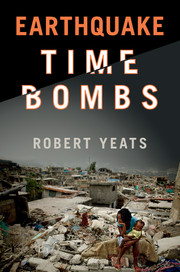Book contents
- Frontmatter
- Contents
- Acknowledgments
- Why this book?
- PART I EARTHQUAKES, DEEP TIME, AND THE POPULATION EXPLOSION
- PART II EARTHQUAKE TIME BOMBS
- TIME BOMBS WHERE THE PROBLEM IS UNDERSTOOD, BUT THE RESPONSE IS STILL INADEQUATE
- 6 San Francisco Bay Area
- 7 Los Angeles
- 8 Seattle, Portland, and Vancouver: Cascadia subduction zone
- 9 Japan: Tokyo and the Kansai
- 10 Wellington, New Zealand
- 11 Santiago, Chile
- 12 Prologue in central China
- OTHER TIME BOMBS, INCLUDING CITIES THAT ARE NOT WELL PREPARED
- PART III SUMMARY AND RECOMMENDATIONS
- References
- Index
8 - Seattle, Portland, and Vancouver: Cascadia subduction zone
from TIME BOMBS WHERE THE PROBLEM IS UNDERSTOOD, BUT THE RESPONSE IS STILL INADEQUATE
Published online by Cambridge University Press: 05 November 2015
- Frontmatter
- Contents
- Acknowledgments
- Why this book?
- PART I EARTHQUAKES, DEEP TIME, AND THE POPULATION EXPLOSION
- PART II EARTHQUAKE TIME BOMBS
- TIME BOMBS WHERE THE PROBLEM IS UNDERSTOOD, BUT THE RESPONSE IS STILL INADEQUATE
- 6 San Francisco Bay Area
- 7 Los Angeles
- 8 Seattle, Portland, and Vancouver: Cascadia subduction zone
- 9 Japan: Tokyo and the Kansai
- 10 Wellington, New Zealand
- 11 Santiago, Chile
- 12 Prologue in central China
- OTHER TIME BOMBS, INCLUDING CITIES THAT ARE NOT WELL PREPARED
- PART III SUMMARY AND RECOMMENDATIONS
- References
- Index
Summary
SCIENTISTS RECOGNIZE THE THREAT
I had been working on earthquake hazards for seven years when I moved from Ohio to western Oregon in 1977. There was a sense of relief that I could study earthquakes while living in Ohio or Oregon and yet not worry about being in the path of an earthquake myself. Certainly, I knew that Oregon, as part of the northwestern United States, is close to the Cascadia subduction zone, the boundary where the oceanic Juan de Fuca tectonic plate is driving eastward beneath North America. However, in 1977 the subduction zone appeared to be unique in the Pacific Ring of Fire in that seismographs are recording essentially no earthquakes on it at all (see Figure 1.3). In addition, there have been no giant earthquakes on the subduction zone in recorded history, meaning since before the days of the Lewis and Clark expedition in 1804–1806. Some scientists believed that subduction was taking place without building up strain to be relieved by an earthquake. So I could work on your earthquake problem without worrying that it might be my problem as well.
However, my scientific colleagues weren't so sure. The USGS had convened a workshop that I attended in Olympia, the Washington State capital, on a possible earthquake hazard to the Pacific Northwest. Scientists at Caltech, including Tom Heaton, discussed in the preceding chapter, were pointing out that, despite the lack of earthquakes, Cascadia is similar to other subduction zones that have had massive earthquakes, including the Chile subduction zone off southern South America that in 1960 had experienced an earthquake of magnitude 9.5, the largest earthquake ever recorded. That earthquake spawned a deadly tsunami that caused damage and loss of life as far away as Japan (see Figure 8.3). Then, in May 1980, Mt. St. Helens volcano blew off its top, spewing pyroclastic flows and ash, and taking 57 lives. Because of the general view that active volcanoes are an indication of active subduction, the Cascade volcanoes suddenly stopped being simply scenic wonders, and the subduction zone suddenly stopped being a scientific curiosity and became a worry to people living nearby, including local scientists.
- Type
- Chapter
- Information
- Earthquake Time Bombs , pp. 101 - 128Publisher: Cambridge University PressPrint publication year: 2015



